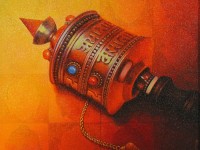

Swapan Roy
Swapan Roy
INTRODUCTION
The best example of how the gentle message of the Compassionate One could rehabilitate the most savage of men is the case of the Emperor Asoka. About two hundred years after the Buddha, this king waged fierce battles across India and caused great anguish and fear. But when he absorbed the Dhamma, he
regretted the evil that he had done. We remember and honor him today because after his conversion to the path of peace, he
embarked on another battle: a battle to bring peace to mankind. He proved without doubt that the Buddha was right when He asserted that true greatness springs from love, not hatred, from humility, not pride; from compassion, not cruelty. The Emperor Asoka
conversion from cruelty to kindness was so complete that he
forbade even the killing of animals in his kingdom.
Buddha was the greatest conqueror the world has ever seen. He
conquered the world with His infallible weapons of love and truth.
His Teaching illuminates the Way for mankind to cross from a world of darkness, hatred, and suffering, to a new world of love, tranquility and happiness.
ABOUT SHOP OWNER

As an artist Swapan Roy is a spiritually devoted person. Through his art he wants to propagate peace in a world overcast with terror and violence. He, therefore, depicts a symbol of peace and continuously works on it to posit a sense of tranquility, sobriety and meditative ways to explore and highlight on the power of human consciousness. On his part as an artist this is a kind of rebellion against the decay of human values. For him Goutam Buddha is the symbol of contemplative spirituality. He paints Buddha in various expressions and moods. For him it is a way of submission to the human glory and exploration of the values that human consciousness can attain. In his present solo show he has painted images of Buddha in various forms and formats. In his depictions he tries to assimilate Indian classicism with Western naturalism. Out of this synthesis he tries to promulgate, albeit very subtly, the ideals of neo-Indian school that searched for an indigenous identity of modernity. Buddha and Buddhism has been the inspiration and perennial source of artistic expression not only in our country but also in other Asian regions where the ideal and religion of Buddhism has spread after it developed into a consolidated religion and philosophy. The word ‘Buddha’, as is well known, etymologically means ‘The Enlightened One’. It is the title of historical person Siddhartha Goutama, who lived between 563 and 483 BC. He was the son of Suddhodhana, King of Sakyas and was born in the village Lumbini near Kapilabastu, now in Nepal. At the age of 29 he came to the realization that there is no lasting pleasure in life and decided to leave home in search of eternal peace. After attaining Bodhi or enlightenment he dedicated his life to the service of humanity and showed the way through which humanity can attain eternal peace through negation of continuous pain and sorrow that constantly engulfs and torments the life. Actually Buddhism was a rebellion against the cast ridden narrow social structure imposed by various superstitions of Vedic religion. It showed a way of human emancipation.
The religion and philosophy propagated by Buddha cast a great influence not only in social development but also in the development of art. From the Mourya period onwards both in architecture, sculpture and painting symbols and images of Buddha played a dominant role, which culminated in Gupta period during AD 400 to 600. Initially in sculptures Buddha was represented though symbols. Probably in art of Gandhara or Mathura before it Buddha was first represented in human figure. The tradition of depicting Buddha in human image has continued since then through various phases of history. In the development of our modernity since neo-Indian school various artists have worked with the image of Buddha. Starting from Nandalal Basu, Asit Kumar Haldar, Chintamoni Kar to the artists of modernist trend like Arpana Caur there are many examples. Swapan Roy out of his social and spiritual commitment has devoted himself towards this artistic trend.
The images of Buddha in his paintings are depicted naturally bringing out an illusion of sculpture three-dimensional with emphasis on meditative tranquility. In the background there are suggestions of historical architectures emanating an environment of tranquil past, where the birds fly spreading the dream of the infinite sky.
In his paintings the finite is transcended into the infinite. Here he connects himself with the great tradition of our classical artistic tradition.
Swapan Roy was born in a rural environment near Calcutta in 1965. After graduating in Commerce from a college in Calcutta he studied in Indian Art College under Rabindra Bharati University from 1986 to 1990. Since then he has completely devoted himself to his creativity. His first solo exhibition was held in Kolkata in July 2010. There he worked on a series of Krishna also on a series on kite. He contains in himself a feeling of transcendentalism, which he has tried to broaden in the present series on Buddha.
Through these images of Buddha he connects himself both with tradition and modernity, also highlights tradition on modernity.
SHIPPING POLICY
After we receive order, paintings will be shipped by reputed courier service only. Paintings will be shipped in rolled format.
REFUND POLICY
Please don’t accept the packet if it seems to be damaged. Paintings once sold will not be returned.
ADDITIONAL POLICY
NO REVIEW AVAILABLE
SHOP PRODUCTS
Products From This Shop


